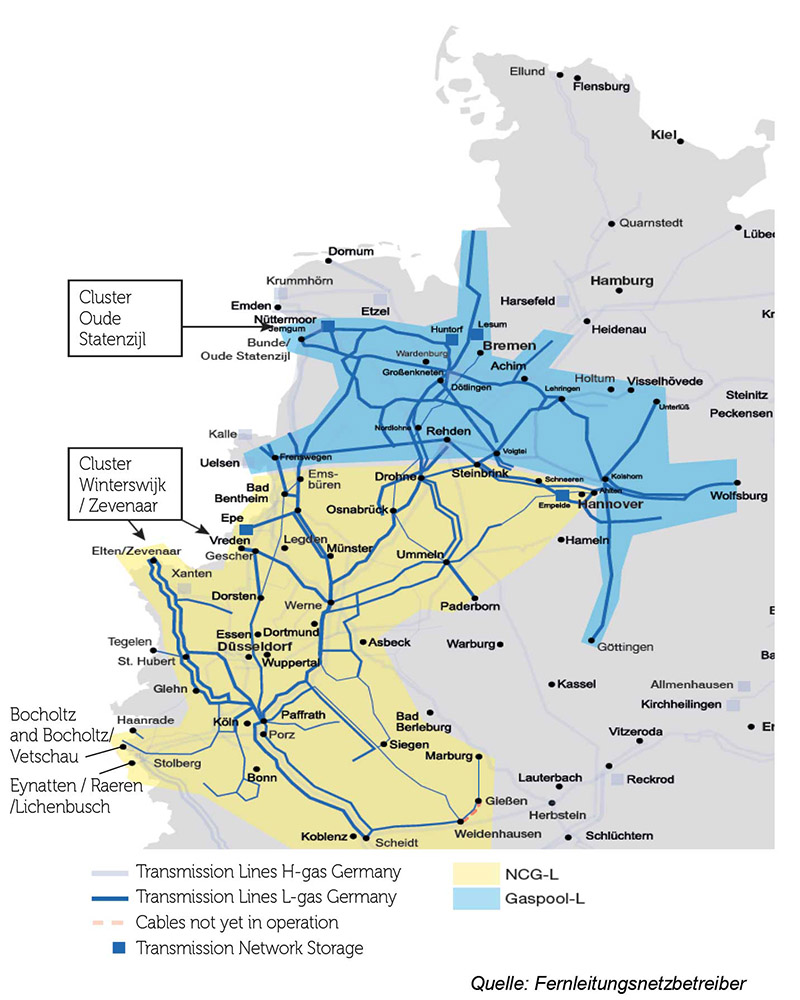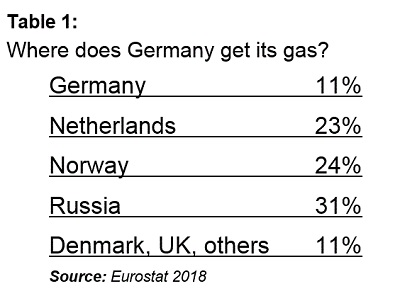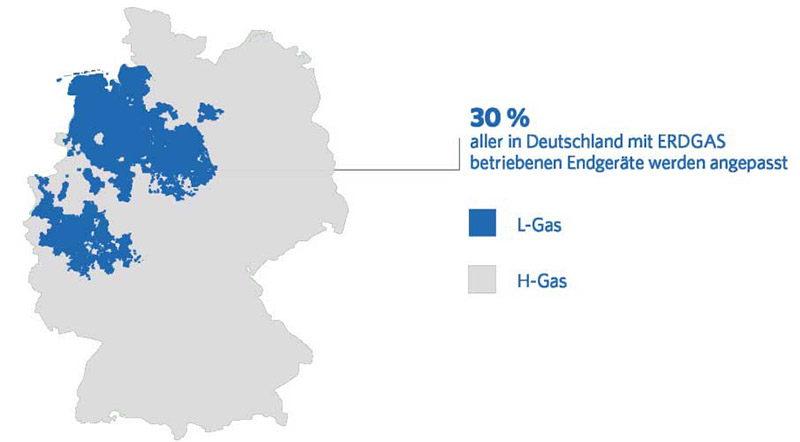April 2018, Vol.245, No.4
Features
The Great German Gas Switch-Over
By Nicholas Newman, Contributing Editor
Germany is at the beginning of a 7 billion euro gas infrastructure project to switch 30% of its gas customers from low-calorie Group L to high calorie Group H natural gas. For technical reasons, and under weights-and-measures regulations, the two gas qualities have to be transported in separate systems within defined ranges, and customers cannot switch from one to the other unless their gas appliances are adjusted. Due for completion by 2030, 57 German utilities will convert the gas appliances of 5 million households, as well as all industrial and biogas plants and gas-fired power stations to Group H natural gas in the two regions. (Figures 1 and 2)

The current gas pipeline network is over 530,000 km in length and the transmission network of 40,000 km delivers 80.5 billion cubic metres (bcm) a year, reports Eurostat. The country’s long-distance gas pipeline network is operated by 15 transmission system operators (TSO) and the local networks by some 700 regional distribution network operators (DSO). Pipeline operators will themselves be working to ensure integration of these two L gas areas with the existing H-grid. Germany’s Transmission System Operator (TSO) Association FNB Gas (Vereinigung der Fernleitungsnetzbetreiber Gas) has put together a pipeline conversion plan known as the Gas Network Development Plan (NDP) 2018 to 2028. Once complete, all retail and wholesale gas customers including utilities will have full access to the most commonly traded gas in the European Single Market. According to the Federal Network Agency, the regulatory office for electricity, gas, telecommunications, post and railway markets, this is Germany’s “biggest infrastructure project for gas supply.”
This switch is necessary, due to the seminal decline in supplies of Group L gas from Lower Saxony and Dutch gas to German customers as seen in Figure 2. The rest of the German market is already supplied with high calorific value quality gas imported from Denmark, Norway/north Sea, Russia and LNG terminals such as GATE in Rotterdam and Fluxys at Zeebrugger.
Composition of L and H Gas
L-gas (low calorific gas) is natural gas with a methane content of 79.8 to 87 percent. Its net calorific value is between 8.2 and 8.9 kilowatt hours per cubic meter. One kilogram of L-gas is equivalent to the energy content of 1.2 litres of gasoline or 1.1 litres of diesel. It contains slightly more nitrogen and CO2 than H-gas. H-gas (high calorific gas) has a methane content of 87 to 99.1 percent and a low level of nitrogen and CO2. Its net calorific value is between 10 and 11.1 kilowatt hours per cubic meter. One kilogram of H-gas has an energy content equivalent to 1.5 litres of diesel.
Sources of Germany’s Natural Gas
Whether L-gas or H-gas is produced depends on the location of the deposit. Groningen is the largest natural gas field in Europe and produces Group L gas. With field maturity has come a decline in Dutch output which has been exacerbated by recent earthquakes. Dutch gas production is forecast to end by 2030 and supplies to Belgium, France and Holland itself will dry up. Consequently, these markets are also making plans to convert their gas networks to carry H gas.
In 2016, Germany consumed 80.5 bcm of natural gas, much of which was imported ,either by pipeline from the North Sea, Siberia or via Holland’s Gate LNG import facility which receives supplies from Qatar, Nigeria and the US. (Table 1)
The Gas Network Development
This market area conversion is Germany’s biggest national infrastructure project and will cost a hefty 7 billion euros. Group L gas customers (Figures 1 and 2) will have their connections converted to accept Group H natural gas during this decade-long program which will also include further development of the H-gas grid. Which grid areas will make the transition and when, will be decided by the Bundesnetzagentur (Federal Network Agency for Electricity, Gas, Telecommunications, Post and Railway) and the transmission system operators. The 57 utilities covering the two areas will be employing around 1,000 technicians to refit or reset up to 500,000 units a year, at the rate of roughly two units per technician per business day. The cost, estimated at just a few euros a year is to be shared by all current L gas customers.
However, practical issues cannot be ignored. The Arbeitsgemeinschaft Erdgasumstellung (Arge EGU), an alliance of 30 distribution system operators dedicated to the natural gas switchover ,have warned “of a shortage in professional technicians in external L and H gas conversion companies.” Technicians are currently undergoing training provided by companies that are being certified for this task. Whether or not these new technicians will be prepared to move from city to city to handle conversions remain to be seen.
Implementation of the NDP
The NDP provides guidance on how they expect the conversion work to proceed, beginning with a 3 year advance notification to local grid network operators for the start of works. This will give the local grid network operator sufficient time to issue a call for tender for outside contractors to compete for the conversion work, select a contractor and sign it off. Traditionally tenders are advertised on the European Union’s Tenders Electronic Daily (TED) an online version of the ‘Supplement to the Official Journal of the European Union’, dedicated to European public procurement. The legal aspects of this project are being managed by Hamburg- based Anwaltskanzlei Bommert, a legal firm specializing in project management.
The Year Before Work Starts
A full year before work is scheduled to begin marks the start of a full -blown publicity and awareness campaign to not only inform but also gain a “social license to operate.” A year- long multi media campaign including local meetings, exhibitions, newspaper articles, broadcasts, leaflets and social media is aimed to create awareness, inform, and gain acceptance for the widely publicized conversion work. Since many of the major cities within the conversion area have up to 35 percent of residents speaking foreign language publicity will be available in English, Turkish, Polish, Russian, French and Arabic. The awareness and publicity campaign will be paralleled by the German police directly informing the public that these services will be provided by bona- fide workmen with corporate IDs, to prevent criminals from entering people’s homes to rob or charge them for the conversion which is free at the point of delivery. In parallel with the publicity and information campaigns a conversion survey detailing a customer’s gas appliances according to type and age will be carried out.
On switchover D-Day for individual households, a single nozzle will be replaced and the air intake adjusted by qualified technicians. However, it is acknowledged that spare parts might not be available for the oldest 5 percent of gas-fired units. These would need to be entirely replaced at the customers own expense. A random sample of about 10% of the conversion work will be checked by a different contractor to ensure that the work undertaken is safe and meets specification.
In conclusion, this decade-long, gas-conversion program covering the northwest corner of Germany guarantees access to gas in the future and is a step towards a single gas market across Germany, Holland, Belgium and France. P&GJ







Comments